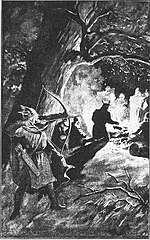Palnatoke

PalnatokeorPalnatoki,sometimes writtenPalna-TokiorPalna Toki(Old Norse:PálnatókiorPálna-Tóki[ˈpɑːlnɑˌtoːke]), was a legendaryDanishhero and chieftain of the island ofFyn.According to theJómsvíkinga saga,Palnatoki founded the brotherhood ofJomsvikingsand established its laws.[1]
According to the Jómsvíkinga saga, he was the son of Palner Tokesen and his wife Ingeborg who was the daughter of theGeatishearlOttar Jarl.[2]Palnatoke raised kingHarald Bluetooth's sonSweyn Forkbeardand was a staunch supporter of the oldpaganfaith. Harald Bluetooth had allowed Christian missionaries from theArchbishop of Hamburg-Bremenmissionary in Denmark and the king himself was baptized once between 960 and 965. Palnatoke convinced Sweyn to wage war on his father. In the mid-980s, Sweyn revolted against his father and seized the throne. Harald was driven into exile and died shortly afterwards. According to some accounts, Palnatoki himself slew Harald.[3]In addition to religious motives, he may have been taking revenge for the death of his grandfather, Jarl Ottar, who was killed when Harald invadedGötaland.
Saxo Grammaticusrelates how Palnatoke (Toko) was forced by King Harald to use a single arrow to shoot an apple from his own son's head as the boy ran downhill. The legendary motif ofthe great archer forced to shoot an apple from his son's headappears among other Germanic nations, as the story ofEgilin theÞiðrekssaga,William of Cloudesley in anEnglishballad, Hemming Wolf inHolstein,Puncher in an Upper Rhenish legend inMalleus Maleficarum,and most famouslyWilliam TellinSwitzerland.[4]
The name has been interpreted in two different ways. The first is as an alternate Old Norse patronymic meaning "Palni's (or Palnir's) (son) Tóki".[5]The other is as a nickname meaning "Shaft-Toki" or "Toki the Archer".[6][7]
Adaptations[edit]
Palnatoki was the subject of works by two influential Danish authors of the early nineteenth century.Adam Gottlob Oehlenschlägerwrote a tragedy calledPalnatokein 1809.N. F. S. Grundtvigwrote a tale calledPalnatokein 1804 and in 1809–11 a two-volume work of poetic drama,Optrin af Kæmpelivets Undergang i Nord( "Episode of the Downfall of the Fighting Life in the North" ), which deals with Palnatoki andSigurðand was intended as part of a massive poetic work projected to consist of dramatised historic episodes and retellings of sagas spanning a thousand years from the coming ofOdinand "Asatru"to Scandinavia through the legends of the Völsungs and Nibelungs until the fall of the Jomsborg with Palnetoki's death, and the victory ofChristianity.[8]
Notes[edit]
- ^Influentially P.A. Munch,Samlede Afhandlinger,Christiania: Storm, 1876. See for example Laurence Marcellus Larson,Canute the Great: 995 (circ.)-1035 and the rise of Danish Imperialism During the Viking Age,New York: Putnam, 1912,p. 155:"the castle probably existed before Toki became prominent in the garrison, if he ever was a member". Gwyn Jones,A History of the Vikings,Oxford University Press, 1973,p. 127,doubts Jomsborg was ever more than "a market-place with its Danish garrison" "imposed" on the Wends by Harald Bluetooth.
- ^"Jomsvikingarnas Saga".Heimskringla.no.RetrievedJanuary 20,2016.
- ^Saxo Grammaticus'Gesta DanorumandJómsvíkinga saga;see Samuel H. Cross, "Scandinavian-Polish Relations in the Late Tenth Century" inStudies in Honor of Hermann Collitz...: Presented by a Group of his Pupils and Friends on the Occasion of his Seventy-Fifth Birthday, February 4, 1930,1930, repr. Freeport, NY: Books for Libraries, 1969, pp. 114-40,p. 122, note 25.
- ^For a full discussion, seeJacob Grimm,Teutonic Mythology,4th ed. tr. James Steven Stallybrass, vol. 1, London: Bell, 1882, pp. 380-83. Also John Fiske,Myths and Myth-Makers: Old Tales and Superstitions Interpreted by Comparative Mythology,Boston: Houghton Mifflin, 1900, repr. BiblioLife, 2009,ISBN1-110-87842-7,pp. 3-6.George Webbe Dasent,Popular Tales from the Norse,3rd ed. Edinburgh: Douglas, 1888, repr. BiblioBazaar 2005,ISBN978-1-113-45357-0,note 5, pp. 403-04has translations of the passages inSaxo Grammaticus'Gesta DanorumBook X,Þiðrekssaga(which he callsWilkina Sagaand Grimm callsVilkinasaga), andMalleus Maleficarum.
- ^Max Keil,Altisländische Namenwahl,Leipzig: Mayer & Müller, 1931,p. 127(German) and a writer inActa Philologica Scandinavica,Volume 5 (1969), p. 146 (Danish) both cite as a parallel Mána-Ljótr, "Ljótr, Máni's son", inSturlunga saga.
- ^"Kenningarnafn(Bezeichnungsname) ",Allgemeine Encyclopädie der Wissenschaften und Künste in Alphabetischer Folge,ed. J.S. Ersch and J.S. Gruber, Leipzig, Brockhaus, 1838,p. 191(German);Toki the Archer(?) ",An Icelandic-English Dictionary,Richard Cleasby, revised, enlarged and completed byGudbrand Vigfusson,Oxford: Clarendon, 1874,p. 475 under "Pálnir".
- ^However, A.G. Moffatt, "Palnatoki in Wales",Saga-Book of the Viking Club3 (1902), 163-73,p. 167takes "Tuke, or Toke" to be "the family name".
- ^N.F.S. Grundtvig, ForfatterskabetArchived2011-07-16 at theWayback Machine,Arkiv for Dansk Litteratur:et kolossalt digterværk, som... skulle bestå af dramatiserede historiske optrin og sagabearbejdelser og i stof og handling række fra guden Odins og dermed asatroens ankomst til Norden over Vølsunge- eller Nibelungensagnene til Jomsborgs undergang ved vikingehøvdingen Palnatokes død og kristendommens sejr.... altså godt 1000 år.Accessed January 7, 2010.
References[edit]
- Jómsvíkíngasaga ok Knytlínga1828 edition.
- Saxo Grammaticus'Gesta Danorum,Book X chapter7,online atRoyal Danish Library.
![]() This article contains content from theOwl EditionofNordisk familjebok,a Swedish encyclopedia published between 1904 and 1926, now in thepublic domain.
This article contains content from theOwl EditionofNordisk familjebok,a Swedish encyclopedia published between 1904 and 1926, now in thepublic domain.
